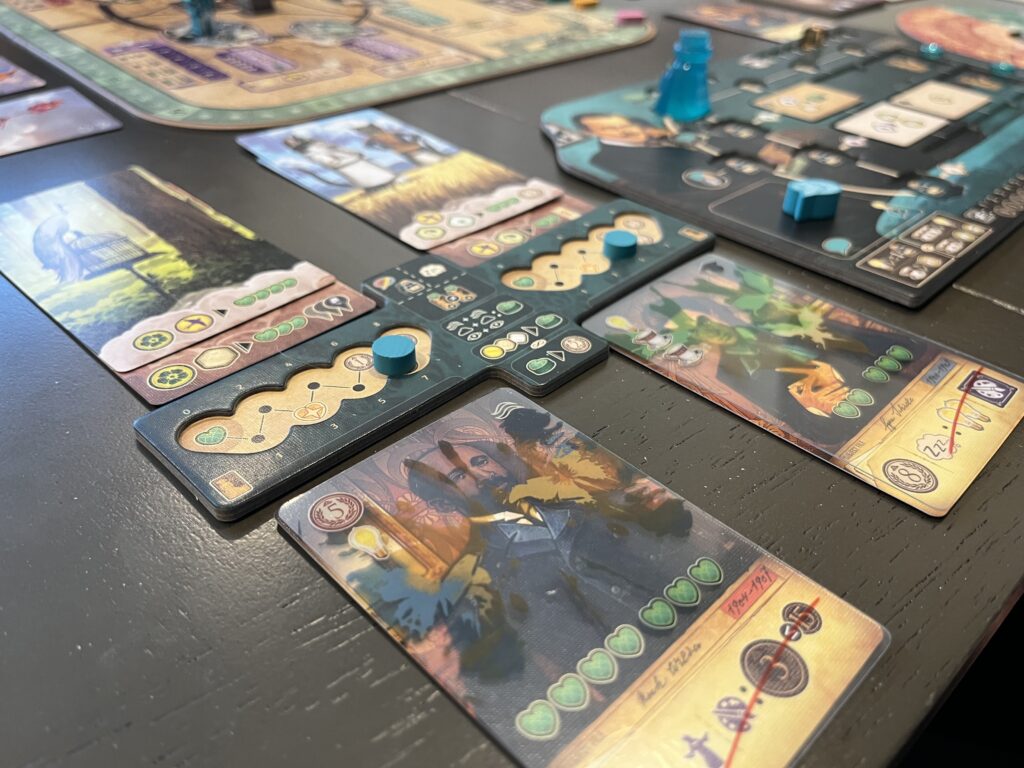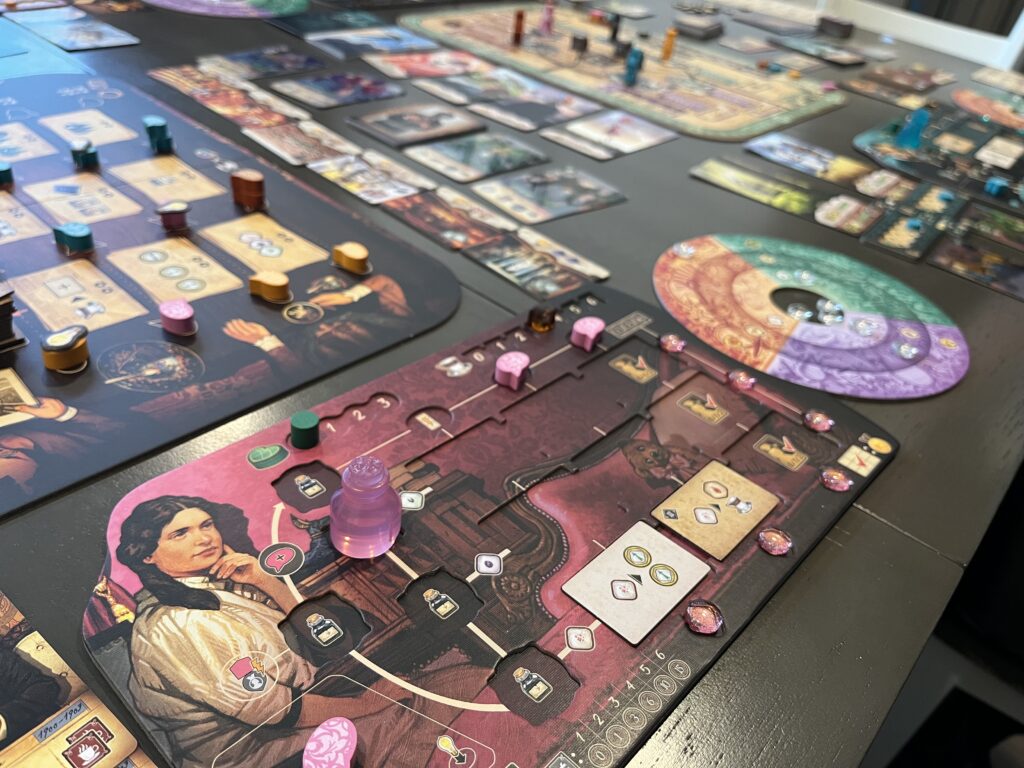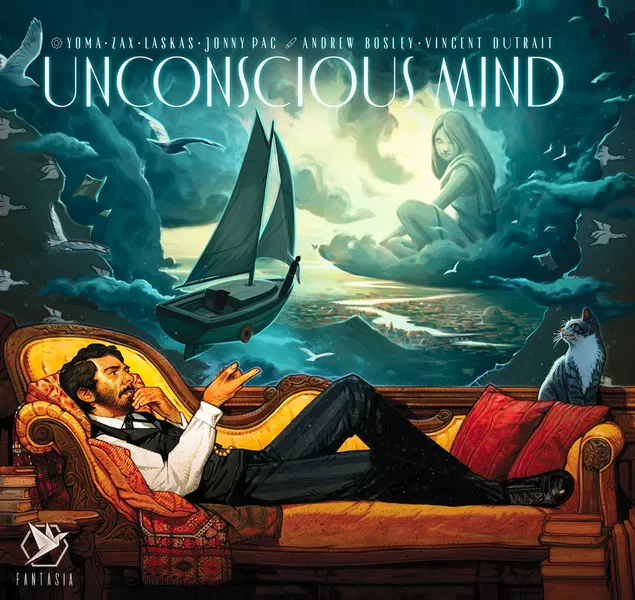Welcome to this week’s gaming post! This week I’m discussing a heavy euro game with a unique theme and beautiful production. So without further ado, let’s jump into my early impressions.
Unconscious Mind
- Designers: Laskas, Jonny Pac, Yoma, Antonio Zax
- Publisher: Fantasia Games
- Complexity: Heavy
- Time: 60-120 Minutes
- Players: 1-4
- Main Mechanisms: Worker Placement, Engine Building, Rondels

I first heard about Unconscious Mind quite a while ago, as it has often appeared on reviewers’ most anticipated lists. However, this year was the year it finally was released, and I recently managed to play a game with a friend who picked up a copy of the game at PAX. I’ll preface that these are only my initial impressions of the game, and as I’ll discuss in more detail below, there’s a lot to this game that won’t be fully realized in just a few plays.
Unconscious Mind is set in the early 1900s with each player taking on the role of psychologist working under Sigmund Freud. The game’s core involves spending insight which are tracked as resources on a dial with three levels (minor, medium, and major) for each of the three insights (growth, freedom, and passion) to treat clients. On your turn, players can either use one of their workers (idea pieces) to take a worker placement spot, recall your workers, or treat clients in their offices.
My favorite part of the game easily is the process of treating clients. I tend to enjoy games that have contract mechanisms since they provide a goal for you to aim for throughout the game. Treating clients operates similarly to completing contracts. When you acquire a new client, you’ll also get two dream cards that each have a requirement to spend a certain amount, type, and level of insight to produce a number of therapy points that are used to cure the client. Once you’ve managed to get enough therapy points to fully cure the client, you’ll receive a certain number of victory points and either gain a bonus for the rest of the game or the client will score you extra victory points based on certain conditions at the end of the game.

I also enjoy the puzzle of managing your insight on the resource dials. As I mentioned earlier, there are three colors of insight with three different levels of each. When you gain a new insight, it will often start at the lowest of the three levels for that particular color. However, over the course of the game, you can take actions that allow you to elevate (i.e., increase their level) or transfer the insight from one type to another. This creates an interesting puzzle where you’re not only focused on gaining resources (insight), but also on converting them into the type and level you need to complete the dream contracts to treat your clients.
Another interesting mechanism involves the worker placement. The worker placement spots each have an associated action that you take when you activate them, but one unique element is that you place your idea markers in between the columns and rotate them to face whichever action you want to activate. That means that some action spaces can be activated from up to four different spots on the board.
The other element to consider when placing your workers is the row they are on. Each row on the board requires you to move your personal inkpot on your player board a certain number of spaces around a rondel. When your inkpot lands on a space, you’ll usually get to activate all of the tiles in the corresponding row or column that you have placed on your player board. These usually allow you to gain and/or spend insight to gain additional benefits. In the recent game I played, I focused heavily on getting a lot of these tiles and using my inkpot to routinely trigger the engine I built.

While curing clients is the overall goal, and likely where you’ll generate the majority of your points, it does feel like this game allows for multiple different strategies. In addition to the worker placement board, there’s also a city map board where you’ll move your figure around another rondel and when you land on a location, you’ll trigger a variety of actions based on the amount of that location’s tags you’ve collected through the game.
One way to generate these tags is from treating clients, but you can also get these tags from publishing treatises. You can acquire research cards throughout the game, corresponding to one of three different colors; once you’ve played these research cards in front of you, you can publish a treatise and score the corresponding number of points if you have the matching number and color of research cards required by the treatise. There’s also an interesting mechanism where you can cite another player’s published treatise and use one of their research cards to complete your own treatise.
In the recent game I played, I focused more on my inkpot, so I only published one small treatise, and I never moved my player piece around the city board. It feels like there’s a lot of different ways to score points, and there are so many areas to the game that it feels like it’s impossible to do everything. This is a positive aspect as I imagine you could play this game many times and end up with different experiences based on which element of the game you chose to focus on more.
Finally, in addition to the interesting theme, I’d be remise if I didn’t mention the game’s production quality. I only played the retail version of the game, but even then, the game comes with nice dual-layer boards, tactile components, and gorgeous art from Andrew Bosley and Vincent Dutrait. Fantasia Games has a good track record when it comes to publishing well-produced games, and this one is certainly no exception.
I don’t have too many negatives to discuss, but I imagine some people are going to have concerns about the overall complexity and number of mechanisms in this game. While I really enjoy another of Fantasia Games’, Endless Winder: Paleoamericans (it just missed out on making my Top 40 Games of All Time), my biggest critique with that game is how disconnected the different mechanisms feel. In that game, there’s worker placement, deck building, set collection, area control, tracks, and more. While better integrated here, Unconscious Mind suffers from a similar problem. In this game, there’s worker placement, multiple rondels, contracts, set collection, resource dials, and more. I touched on how this offers multiple different strategies to pursue in the positives section above, but I can’t help but wonder if certain aspects of the game could have been removed or streamlined to give the game a more cohesive feel.
My only other slight nitpick with the game are the limited number of client cards. There’s only 12 of each of the basic and advanced cards in the base game, so in the four-person game I played, we ended up going through almost all of them by the end of the game. I would have loved to see more clients in the game, as after a couple of plays, you’ll likely have seen all of them. This feels like a ripe area for an expansion to not only add more total cards, but also introduce a bit more variety in this department.
Overall, I really enjoyed my initial experience with Unconscious Mind, and I can see why reviewers are including the game on their Top 10s of 2024. I can’t wait to visit this game again in the near future to try out some of the other strategies the game offers.
With that, I’ll wrap up this week’s gaming highlights! I’d love to hear your thoughts on any of the games I’ve mentioned, future content, or format in the comments section below. Happy gaming!
If you liked this post and want to be notified when new content is released, then follow me on Instagram @themeepledigest.
